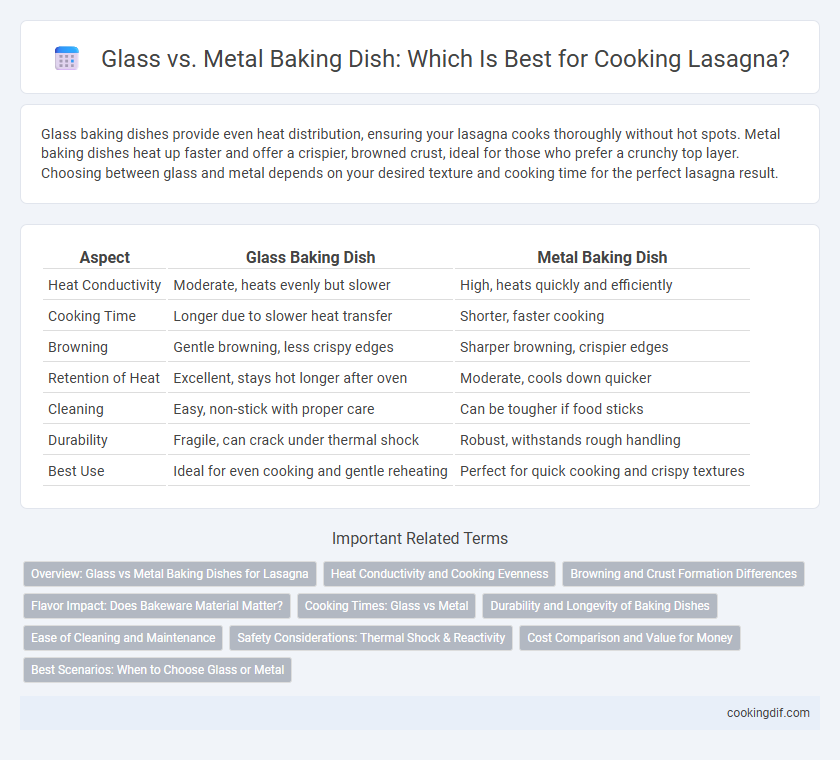Glass baking dishes provide even heat distribution, ensuring your lasagna cooks thoroughly without hot spots. Metal baking dishes heat up faster and offer a crispier, browned crust, ideal for those who prefer a crunchy top layer. Choosing between glass and metal depends on your desired texture and cooking time for the perfect lasagna result.
Table of Comparison
| Aspect | Glass Baking Dish | Metal Baking Dish |
|---|---|---|
| Heat Conductivity | Moderate, heats evenly but slower | High, heats quickly and efficiently |
| Cooking Time | Longer due to slower heat transfer | Shorter, faster cooking |
| Browning | Gentle browning, less crispy edges | Sharper browning, crispier edges |
| Retention of Heat | Excellent, stays hot longer after oven | Moderate, cools down quicker |
| Cleaning | Easy, non-stick with proper care | Can be tougher if food sticks |
| Durability | Fragile, can crack under thermal shock | Robust, withstands rough handling |
| Best Use | Ideal for even cooking and gentle reheating | Perfect for quick cooking and crispy textures |
Overview: Glass vs Metal Baking Dishes for Lasagna
Glass baking dishes provide even heat distribution and retain heat longer, resulting in consistent cooking and a well-set lasagna. Metal baking dishes, often made from aluminum or stainless steel, heat up quickly and promote a crispier, browned crust on the edges. Choosing between glass and metal depends on whether you prefer a uniformly cooked lasagna or a browned, crispy finish.
Heat Conductivity and Cooking Evenness
Metal baking dishes offer superior heat conductivity compared to glass, allowing lasagna to cook more quickly and develop a crispier crust. Glass baking dishes retain heat longer, promoting even cooking and preventing hot spots that can cause uneven layers. Choosing between glass and metal depends on desired texture and cooking speed, with metal ideal for browning and glass better for uniform heat distribution.
Browning and Crust Formation Differences
Glass baking dishes provide even heat distribution that promotes slower browning and a softer crust on lasagna, preserving moisture within the layers. Metal baking dishes conduct heat more efficiently, resulting in faster browning and a crisper, more defined crust, especially on edges. Home cooks aiming for a golden, crunchy top often prefer metal pans, while glass is favored for gentle, consistent cooking that maintains lasagna's tenderness.
Flavor Impact: Does Bakeware Material Matter?
Glass baking dishes provide even heat distribution and retain heat longer, resulting in a consistent cook and slightly caramelized edges that enhance lasagna's rich flavors. Metal baking dishes, typically aluminum or stainless steel, heat up faster and produce crispier crusts, which can intensify the texture contrast in lasagna layers. The choice between glass and metal affects moisture retention and browning, ultimately influencing the balance between a tender interior and a flavorful, crispy top.
Cooking Times: Glass vs Metal
Glass baking dishes typically require longer cooking times than metal because glass heats more slowly and retains heat longer, leading to more even cooking but slower initial heat transfer. Metal baking dishes heat up quickly and promote faster browning, reducing overall cooking time but increasing the risk of hot spots and uneven cooking. Adjusting cooking time by 5 to 10 minutes when switching between glass and metal can ensure optimal lasagna texture and doneness.
Durability and Longevity of Baking Dishes
Glass baking dishes offer excellent durability by resisting scratches and stains, maintaining clarity over many uses, while metal baking dishes, particularly stainless steel or anodized aluminum, provide superior longevity due to their resistance to warping and higher heat tolerance. Metal pans conduct heat more efficiently, leading to even cooking and a crispier crust, but they can dent or rust if not properly cared for. Glass dishes are less prone to corrosion and allow for visual monitoring of the lasagna, making them a reliable option for long-term use, although they may be more susceptible to breakage if dropped.
Ease of Cleaning and Maintenance
Glass baking dishes offer non-porous surfaces that resist staining and are dishwasher safe, simplifying cleaning and reducing maintenance efforts compared to metal. Metal baking dishes, especially those with non-stick coatings, require careful hand washing to prevent scratches and maintain their finish, making them slightly more labor-intensive. For ease of cleaning and long-term upkeep, glass dishes provide a more durable and low-maintenance option for cooking lasagna.
Safety Considerations: Thermal Shock & Reactivity
Glass baking dishes provide even heat distribution but are susceptible to thermal shock, which can cause cracking if exposed to sudden temperature changes. Metal baking dishes, typically made from aluminum or stainless steel, tolerate rapid temperature shifts better and do not shatter but may react with acidic tomato sauces, potentially altering flavor and safety. Choosing between glass and metal depends on maintaining steady oven temperatures to prevent glass damage and selecting non-reactive materials to ensure safe cooking with acidic ingredients.
Cost Comparison and Value for Money
Glass baking dishes generally cost more upfront than metal baking dishes but offer greater durability and even heat distribution, providing better value for money over time. Metal baking dishes are typically less expensive, heat up faster, and are lightweight, making them ideal for quick cooking but may warp or degrade with frequent use. Considering longevity and performance, glass dishes tend to be a more cost-effective choice for lasagna preparation in the long run.
Best Scenarios: When to Choose Glass or Metal
Glass baking dishes provide even heat distribution, making them ideal for slow-cooked lasagna recipes that require steady, gentle cooking to melt cheese layers without burning. Metal baking dishes heat up quickly and retain high heat, perfect for lasagna that benefits from a crispy, browned top crust and shorter baking times. Choosing glass is best for recipes emphasizing moisture and uniform cooking, while metal suits lasagna styles needing robust, high-heat exposure.
Glass baking dish vs metal baking dish for cooking Infographic

 cookingdif.com
cookingdif.com